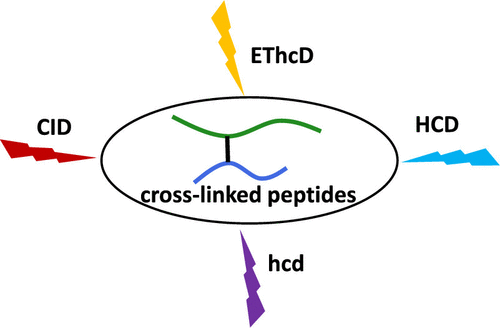当前位置:
X-MOL 学术
›
J. Proteome Res.
›
论文详情
Our official English website, www.x-mol.net, welcomes your
feedback! (Note: you will need to create a separate account there.)
Use of Multiple Ion Fragmentation Methods to Identify Protein Cross-Links and Facilitate Comparison of Data Interpretation Algorithms.
Journal of Proteome Research ( IF 3.8 ) Pub Date : 2020-06-04 , DOI: 10.1021/acs.jproteome.0c00111 Bingqing Zhao 1 , Colin P Reilly 1 , Caroline Davis 2 , Andreas Matouschek 2 , James P Reilly 1
Journal of Proteome Research ( IF 3.8 ) Pub Date : 2020-06-04 , DOI: 10.1021/acs.jproteome.0c00111 Bingqing Zhao 1 , Colin P Reilly 1 , Caroline Davis 2 , Andreas Matouschek 2 , James P Reilly 1
Affiliation

|
Multiple ion fragmentation methods involving collision-induced dissociation (CID), higher-energy collisional dissociation (HCD) with regular and very high energy settings, and electron-transfer dissociation with supplementary HCD (EThcD) are implemented to improve the confidence of cross-link identifications. Three different S. cerevisiae proteasome samples cross-linked by diethyl suberthioimidate (DEST) or bis(sulfosuccinimidyl)suberate (BS3) are analyzed. Two approaches are introduced to combine interpretations from the above four methods. Working with cleavable cross-linkers such as DEST, the first approach searches for cross-link diagnostic ions and consistency among the best interpretations derived from all four MS2 spectra associated with each precursor ion. Better agreement leads to a more definitive identification. Compatible with both cleavable and noncleavable cross-linkers such as BS3, the second approach multiplies scoring metrics from a number of fragmentation experiments to derive an overall best match. This significantly increases the scoring gap between the target and decoy matches. The validity of cross-links fragmented by HCD alone and identified by Kojak, MeroX, pLink, and Xi was evaluated using multiple fragmentation data. Possible ways to improve the identification credibility are discussed. Data are available via ProteomeXchange with identifier PXD018310.
中文翻译:

使用多种离子碎片方法来识别蛋白质交联并促进数据解释算法的比较。
实现了涉及碰撞诱导解离(CID),具有常规和非常高能量设置的高能碰撞解离(HCD)以及具有辅助HCD的电子转移解离(EThcD)的多种离子裂解方法,以提高交联的置信度标识。分析了三种不同的酿酒酵母蛋白酶体样品,它们分别通过亚硫代次亚氨酸二乙酯(DEST)或双(磺基琥珀酰亚胺基)硫酸氢盐(BS 3)交联。引入了两种方法来结合以上四种方法的解释。与可裂解的交联剂(例如DEST)一起使用,第一种方法在所有四个MS 2衍生的最佳解释中搜索交联诊断离子和一致性。与每个前体离子相关的光谱 更好的协议会导致更明确的标识。第二种方法与诸如BS 3之类的可裂解和不可裂解的交联剂都兼容,第二种方法是将来自多个片段化实验的得分指标相乘以得出总体最佳匹配。这大大增加了目标比赛与诱饵比赛之间的得分差距。使用多个片段化数据评估了仅由HCD片段化并由Kojak,MeroX,pLink和Xi识别的交联的有效性。讨论了提高识别可信度的可能方法。数据可通过ProteomeXchange获得,其标识符为PXD018310。
更新日期:2020-07-02
中文翻译:

使用多种离子碎片方法来识别蛋白质交联并促进数据解释算法的比较。
实现了涉及碰撞诱导解离(CID),具有常规和非常高能量设置的高能碰撞解离(HCD)以及具有辅助HCD的电子转移解离(EThcD)的多种离子裂解方法,以提高交联的置信度标识。分析了三种不同的酿酒酵母蛋白酶体样品,它们分别通过亚硫代次亚氨酸二乙酯(DEST)或双(磺基琥珀酰亚胺基)硫酸氢盐(BS 3)交联。引入了两种方法来结合以上四种方法的解释。与可裂解的交联剂(例如DEST)一起使用,第一种方法在所有四个MS 2衍生的最佳解释中搜索交联诊断离子和一致性。与每个前体离子相关的光谱 更好的协议会导致更明确的标识。第二种方法与诸如BS 3之类的可裂解和不可裂解的交联剂都兼容,第二种方法是将来自多个片段化实验的得分指标相乘以得出总体最佳匹配。这大大增加了目标比赛与诱饵比赛之间的得分差距。使用多个片段化数据评估了仅由HCD片段化并由Kojak,MeroX,pLink和Xi识别的交联的有效性。讨论了提高识别可信度的可能方法。数据可通过ProteomeXchange获得,其标识符为PXD018310。









































 京公网安备 11010802027423号
京公网安备 11010802027423号